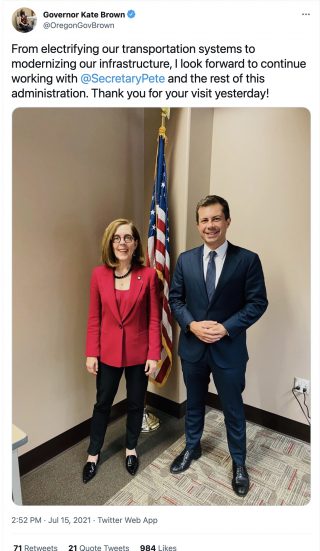
This opinion is from Chris Smith, a co-founder of No More Freeways and a member of the Portland Planning Commission. He previously wrote for us about bicycling the ‘last mile’ and his race for Metro Council.

Four years ago, I convened the group that became No More Freeways PDX to oppose the Rose Quarter Freeway Expansion in Portland because it was not good for our city or our planet (we’re having our birthday party at the end of August!). We continue to fight that project on a number of fronts, but ODOT is planning urban freeway expansions in other parts of our region:
- Widening of Highway 217 (project page)
- Adding a third lane in both directions to I-205 from Stafford Road to the Abernethy Bridge in Clackamas County and widening the bridge (in Oregon City) to three lanes in each direction (project page)
- The Columbia River Crossing 2.0 (which ODOT and WSDOT have rebranded as the Interstate Bridge Replacement Project), reviving a 12-lane design from a decade ago
- Widening I-5 near Wilsonville, which ODOT is framing as a replacement of the Boone Bridge (project page)
Last week I watched with disgust (if not surprise) as the Joint Policy Advisory Committee on Transportation; the committee of local elected leaders which, in conjunction with Metro Council, governs transportation funding in the region, advanced funding plans for two of these projects on their ‘consent agenda’, i.e., without a debate or vote on the specific plans. Metro’s vote came in spite of compelling testimony from the youth climate activists at Sunrise PDX.
It seems that any time we ask for more funding for transit, biking or walking our government agencies cry poverty, but when billions of dollars of freeway widening are on the line, our state and local governments don’t raise any objection.
In 2021, we simply can no longer tolerate elected leaders approaching freeway widenings on auto-pilot, especially any local leader who ostensibly claims to care about the climate emergency that just killed over 100 Oregonians.
[Related: From 2017, It can happen here: The normalization of freeway expansions]
These funding plans for Highway 217 and the Abernethy Bridge are on the agenda for the July 29th Metro Council meeting. It’s vitally important that we tell the Metro Council that these projects are not ‘just normal’ any more. Here’s why:
Advertisement
Think Globally, Act Locally
There is strong consensus among climate scientists that Oregon’s drought, wildfires and last month’s “heat dome” are directly related to global climate disruption. We are feeling the impacts of greenhouse gases released globally, but 40% of our local contribution to GHG emissions comes from transportation and it’s rising, even as emissions from other sources are trending down (although not as quickly as we need).
The Regional Transportation Plan Has Become a Suicide Pact
A number of these projects have been in the Regional Transportation Plan (the region’s federally-mandated list of high-priority projects) for years, if not decades. During that time, our understanding of the climate emergency has only become clearer and more urgent. Other policies in the RTP to reduce traffic demand have simply not worked. It’s time to recognize that the RTP does not work for our community!
It’s Not About Congestion

Elected officials like to hide behind congestion: “If we get traffic flowing freely,” they say, “emissions at the bottleneck will go down.” But overall analysis of the system tells us that there is a direct relationship between roads and emissions. I won’t go into the details of induced demand here, but the data is clear: if you add 1% more lane-miles, you get 1% more traffic (and emissions).
As detailed in Transportation For America’s Congestion Con report, Between 1993 and 2017, the 100 largest urbanized areas in the United States spent more than $500 billion adding new freeways or expanding existing ones. In those same cities, congestion increased by 144 percent, significantly outpacing population growth. Given their regional portfolio and governing priorities, Metro is well-situated to be the government agency to call ODOT’s bluff on their nonsensical claims about congestion relief. Our region absolutely needs to address traffic congestion – it’s time Metro pointed out that ODOT clearly doesn’t intend to solve it.
Electrification Will Not Save Us

Elected officials like to hide behind electric vehicles (see image at right).
While electrification of our fleet will reduce GHG emissions, it’s not sufficient by itself. The best numbers available tell us that even with aggressive electrification, we need to reduce driving by 20% or more to balance our carbon books to avoid the worst impacts of climate change. And to be clear – we’re not seeing anywhere near an aggressive uptake of vehicle electrification at this point.
So far in 2021, fewer than 250,000 EVs have been sold in the US. Meanwhile, light trucks like the Ford F-150 continue to dominate: over 1 million were sold in just the last month. These cars will be on our roads for as much as two decades. It’s simply imperative we build communities where Oregonians have alternatives to driving for every trip, and dumping billions into freeways robs us of the resources we need for this shift.
Price Before You Build
“Good policy would impose pricing first, then assess whether the resulting demand warrants new capacity in the system.”
We are slowly moving to a consensus in Oregon that we have to price use of our road system. But we have not yet converged on a strategy to do that well. Good policy would impose pricing first, then assess whether the resulting demand warrants new capacity in the system. Incredibly, for both the Rose Quarter and Abernethy Bridge, ODOT will first build the roads, then toll them later to pay off bonds. Decades of research show that congestion pricing is the only tool proven to tackle not only recurring traffic jams but also reduce both air pollution, carbon emissions. Both the City of Portland and Metro have undertaken significant work to think about the equitable implementation of pricing roads – ODOT’s freeway expansions and subsequent tolling for revenue (not for congestion relief) preempt local and regional efforts to implement this policy more in line with equity, climate, public health or congestion relief goals.
How You Price, Matters
By tolling the Abernethy Bridge, ODOT is basically putting themselves in the situation where they need sustained levels of traffic to pay off the project bonds. Reductions in driving to help GHG emissions would break their financial model. We’re baking ongoing GHG emissions into the project!
In contrast, congestion pricing to manage demand over the bridge would include the option to spend the revenue generated on offsetting programs (like transit or active transportation) to reduce demand and increase equity. The last thing Oregon needs, as the state suffers from over 400,000 acres of wildfires currently burning before the beginning of August, is to create perverse financial incentives for the state to need to perpetuate carbon-intensive driving to pay off bonds.
Tell Metro to Vote No on July 29th
For all these reasons we need to tell Metro Council to not vote for ‘business as usual’ for these projects. Ask Metro to deny approval of Resolution No. 21-5188 (Highway 217) and Resolution No. 21-5192 (I-205 Abernethy Bridge). Our elected officials don’t fully realize how many of us are feeling the climate anxiety from the last few months, and how strongly we understand the link between these terrible freeway expansions and our rising oceans and burning forests. They need to hear from us. Please contact your Metro Councilor before their vote.
You can also submit testimony to the July 29th meeting in advance, or you can join the meeting via Zoom at 2:00 pm where you can raise your hand to testify (agenda pending). Drop us an email at No More Freeways if you have more questions or want some help thinking through your oral or written testimony.
— Chris Smith, @chrissmithus on Twitter.
— Get our headlines delivered to your inbox.
— Support this independent community media outlet with a one-time contribution or monthly subscription.

